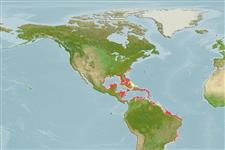Environment: milieu / climate zone / depth range / distribution range
Ecologia
marinhas associadas(os) a recifes. Tropical
Southwestern Atlantic: Belize, Central America, and Puerto Rico; Caribbean, to
Santa Catarina State, southern Brazil.
Tamanho / Peso / Idade
Maturity: Lm ? range ? - ? cm
Max length : 8.2 cm TL macho/indeterminado; (Ref. 13628)
Espinhos dorsais (total) : 20; Raios dorsais (total) : 9 - 11; Espinhos anais: 2; Raios anais : 7 - 21. This species is distinguished from its southwestern Atlantic congeners by the following set of characters: D XX,9-11 (rarely XIX or XXI); A II,17-21; pectoral-fin rays14-15 (rarely 13); length of third pelvic-fin ray contained 2.5 to 3.0 times in second pelvic-fin ray; lateral-line scales 48-56; total nuchal cirri 24-36; pectoral-fin base and midline before dorsal-fin no scales; breast usually fully scaled in males, often naked in females; pores 2-3 from preopercular canal onto opercle. Colouration: pattern dominated by 5-6 (rarely 7), saddle-like bars on body, extending to spiny dorsal fin (Ref. 123106).
Occurs in shallo reefs (Ref. 123106), on sandy bottoms and Thalassia testudinum beds (Ref. 13628). Feeds mainly on crustaceans but also on gastropods and worms (Ref. 13628).
Ciclo de vida ou comportamento de acasalamento
Maturities | Reprodução | Spawnings | Egg(s) | Fecundities | Larvas
Carvalho-Filho, A., I. Sazima, S.M.Q. Lima, D. Almeida, L. Mendes, R.M. Dias, M.R. Britto and J.L. Gasparini, 2020. Review of the genus Malacoctenus (Actinopterygii: Labrisomidae) from the Southwestern Atlantic, with description of two new species. Zootaxa 4819(3):499-520. (Ref. 123106)
Status na Lista Vermelha da UICN (Ref. 130435)
Ameaça para os humanos
Harmless
Uso pelos humanos
Ferramentas
Relatórios especiais
Baixar XML
Fontes da internet
Estimates based on models
Preferred temperature (Ref.
123201): 24.1 - 28.1, mean 27.3 °C (based on 722 cells).
Índice de diversidade filogenética (Ref.
82804): PD
50 = 0.5000 [Uniqueness, from 0.5 = low to 2.0 = high].
Bayesian length-weight: a=0.00603 (0.00294 - 0.01235), b=3.08 (2.89 - 3.27), in cm total length, based on LWR estimates for this species & (Sub)family-body (Ref.
93245).
Nível Trófico (Ref.
69278): 3.4 ±0.49 se; based on food items.
Resiliência (Ref.
120179): médio(a), tempo mínimo de duplicação da população 1,4 - 4,4 anos (Fec = 4,000).
Fishing Vulnerability (Ref.
59153): Low vulnerability (10 of 100).
Nutrients (Ref.
124155): Calcium = 146 [72, 238] mg/100g; Iron = 0.757 [0.435, 1.292] mg/100g; Protein = 18.2 [17.1, 19.3] %; Omega3 = 0.0978 [, ] g/100g; Selenium = 22.2 [9.4, 48.7] μg/100g; VitaminA = 181 [57, 582] μg/100g; Zinc = 2.25 [1.47, 3.24] mg/100g (wet weight);
